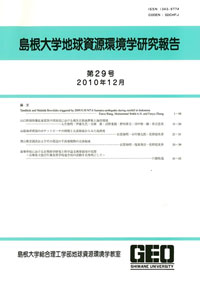島根大学総合理工学部地球資源環境学教室
ISSN:1343-9774

number of downloads : ?
Use this link to cite this item : https://ir.lib.shimane-u.ac.jp/38868
Geoscience reports of Shimane University 35
2016-12 発行
Geochemical examination of gold mining waste at Nzunguni in central Tanzania
タンザニア中央部のズグニにおける金鉱山の廃棄物の地球化学的検討
File
Description
Waste of gold mining at Nzunguni, central Tanzania was analyzed by X-ray fluorescence analysis (XRF) using the press powder method to evaluate environmental impact to the surrounding area. Gold (Aurum) occurred within quartz vein (reef) in the host granitic rock, which was separated by crushing the quartz vein and concentrated by gravity separation process on the slope. Mercury (Hg) was used for more concentration, but this process was not common in this site. Samples were collected at the gravity separation site, which were light yellowish gray silt. Aurum was detected in all 11 samples, even though only by qualitative analysis. This is because Au bearing standard powder was not obtained yet. Mercury was not detected for two samples which were treated with Hg at the site. Copper concentrations show variation from 500 to 1200 ppm suggesting relation of Au or Au bearing minerals. High Fe_2O_3 concentrations (10-19 wt%) in waste materials may be mainly derived from secondary formed iron oxide in cracks of quartz veins. Zn, Pb, Cr, Ni and V did not show high concentrations indicating absence of heavy minerals in the veins. Stream sediments did not show deviation of both Cu and Hg, suggesting negligible effects of contamination from the smelting process.
Other Article
PP. 7 - 16
